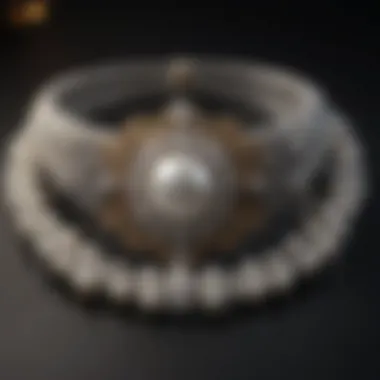Understanding Philippine Pearls: A Comprehensive Guide


Intro
Philippine pearls stand as a hallmark of quality in the world of gemstones. They capture the attention of collectors and jewelry designers alike with their unique beauty, history, and cultural significance. Understanding the nuances of these gems involves exploring their origins, classification, and the market dynamics that influence their availability and value.
As we delve into this guide, it is crucial to recognize the importance of meticulous cultivation practices and grading systems. These factors not only determine the quality of pearls but also impact their investment potential. Moreover, practical considerations for purchasing and caring for Philippine pearls will be addressed, ensuring that readers are well-informed about maintaining these exquisite gemstones. Let us begin with an overview of what makes these gems truly remarkable.
Gemstone Overview
Definition and Characteristics
Philippine pearls are organic gems formed in mollusks, specifically the Pinctada maximus species found in the country’s waters. They are renowned for their luster, unique colors, and overall quality. These pearls come in various shapes, including round, oval, and baroque. The surface texture can range from smooth to heavily textured, influencing the gem’s aesthetic appeal.
Typically, the most valued pearls exhibit a high degree of iridescence and a mirror-like finish. Their colors vary significantly, from classic white and cream to deeper shades of gold, pink, and even black. The choice of color often influences the demand and pricing in the market.
Classification of Gemstones
Gemstones are often classified based on several criteria, including their origin, type, and formation processes. Pearls are generally categorized into two main types: natural and cultured.
- Natural Pearls: These form spontaneously in the wild without human intervention. Their rarity makes them highly sought after and valuable.
- Cultured Pearls: Resulting from human intervention, these are more common and come from farming environments. The majority of pearls on the market today fall into this category.
Cultured pearls can further be categorized based on their type:
- Akoya Pearls: Known for their classic roundness and high luster, often produced in Japan but also found in the Philippines.
- Tahitian Pearls: Often dark and exotic, these are produced from the black-lipped oyster.
- South Sea Pearls: Large and luxurious, these primarily come from the silver-lipped oyster, celebrated for their creamy colors and significant size.
Each classification highlights unique characteristics that not only enrich their allure but also determine their value in the gemstone market.
"The beauty of pearls from the Philippines is a combination of nature's art and careful human cultivation."
Historical Significance
Ancient Uses and Cultural Importance
Throughout history, pearls have been symbols of wealth and status across cultures. In the Philippines, they have held substantial significance, often being a part of traditional jewelry worn on special occasions. They have been used not only as adornments but also as offerings in rituals and ceremonies.
Local communities often pass down pearl diving techniques through generations, preserving the heritage associated with these gems. The connection between culture and pearls is a testament to their enduring beauty and significance in Philippine society.
Myths and Legends Surrounding Gemstones
Pearls are steeped in various myths and legends. In Filipino culture, they are often seen as symbols of purity and prosperity. Various folktales attribute mystical properties to pearls, supporting their value and significance. They are regarded as gifts from the sea, blessed by the divine, which enhances their allure as prized possessions.
In essence, the intrigue surrounding Philippine pearls extends beyond their physical attributes. It is a combination of quality, heritage, and rich narratives that continues to captivate gemstone enthusiasts, collectors, and jewelry designers alike.
Preamble to Philippine Pearls
Philippine pearls hold a unique place in the world of gemstones. The country's geographical features and rich marine biodiversity contribute to the exceptional quality and beauty of its pearls. These gemstones not only possess aesthetic appeal but also carry significant economic and cultural importance. Understanding the nuances of Philippine pearls can aid enthusiasts, collectors, and jewelry designers in making informed decisions regarding their purchase and investment.
Defining Philippine Pearls
Philippine pearls are cultivated from various species of oysters found in the country's warm, tropical waters. Primarily, these pearls are produced from the Pinctada maxima and Pinctada fucata oyster species. The color, size, and luster of these pearls can vary significantly. Factors such as water quality, location, and cultivation techniques influence their development. Overall, a clear definition of what constitutes Philippine pearls is essential for both consumers and investors who wish to navigate this intricate market with confidence.
Historical Significance
The history of Philippine pearls is deeply intertwined with the nation's culture and economy. For centuries, they have been cherished by various communities, often considered symbols of wealth and status. Historical records highlight their use in regal adornments and traditional ceremonies. Additionally, the export of these pearls has played a notable role in the Philippines' trade relations with other countries, enhancing its reputation in the global gemstone market.
The production and trade of Philippine pearls reflect a blend of artisanal skills passed down through generations. The traditional methods, while facing modern challenges, remain vital for preserving the unique identity of these pearls. Through understanding their historical significance, one gains a better appreciation of the craftsmanship and cultural heritage behind these exquisite gems.
"Philippine pearls are not just beautiful; they embody the history and artistry of the Philippines."
This comprehensive understanding of both the definition and historical relevance of Philippine pearls is crucial as it sets the stage for deeper exploration into their cultivation, classification, and market dynamics in subsequent sections.
The Oyster Species Behind the Pearls
The significance of oyster species in the world of pearls cannot be understated. The type of oyster from which a pearl is formed plays a crucial role in determining the characteristics of the pearl itself. This section will highlight two primary species known for producing the exquisite pearls commonly found in the Philippines: Pinctada maxima and Pinctada fucata. Each species has its unique traits and influences the quality, size, and color of the pearls.
Pinctada maxima
Pinctada maxima, commonly referred to as the gold-lipped or silver-lipped oyster, is one of the largest pearl-producing bivalves. This oyster is predominantly found in the tropical and subtropical waters of the Indo-Pacific region, making it widely available in the Philippines. Its size is significant, with some reaching up to 12 inches in diameter.
The importance of Pinctada maxima lies in the quality of the pearls it generates. These oysters are known for producing high-luster pearls, often featuring a lovely and rich color palette. The pearls produced from this oyster typically range from white to golden hues, appealing to collectors and jewelry designers alike. Their nacre quality, which refers to the layers of aragonite and conchiolin that form the pearl, is also superior, enhancing the overall appearance and value of the pearls.
Several factors influence the cultivation of Pinctada maxima. The oyster's habitat must be carefully monitored, as environmental conditions, such as water quality and temperature, affect growth rates and health. Aquaculture practices focusing on sustainability are essential to maintain the oyster population and ensure the longevity of pearl farming.
Pinctada fucata
Another noteworthy species is Pinctada fucata. This oyster, often referred to as the Akoya oyster, is smaller than Pinctada maxima. It typically measures around 4 to 5 inches in diameter. Found mainly in the coastal waters of Japan, China, and the Philippines, Pinctada fucata is renowned for its ability to produce exquisite, high-luster pearls.
The pearls from Pinctada fucata are usually smaller, averaging between 2 to 10 mm in size. However, their appeal lies in their brilliant sheen and round shape, making them a popular choice for pearl jewelry, especially necklaces and earrings. The color of these pearls can vary, often exhibiting hues of white, cream, or silver, which can also be enhanced through the cultivation process. Some producers even successfully create colored variations, including pink and blue pearls.
Cultivating Pinctada fucata requires a great deal of skill and dedication. The farming environment must be meticulously controlled to achieve optimal growth. Challenges like water pollution, ocean climate shifts, and overharvesting can impact the health and productivity of these oysters. This necessitates a strong emphasis on sustainable practices to ensure that the oyster populations and pearl quality are preserved for future generations.


"The oyster species are not just the foundation of pearl quality; they symbolize the harmony between nature and cultivation practices."
Thus, understanding these oyster species enables enthusiasts, collectors, and jewelry designers to appreciate the complexities behind the beauty of Philippine pearls. Each species contributes uniquely to the industry, making comprehensive knowledge essential for any stakeholders.
Cultivation of Philippine Pearls
The cultivation of Philippine pearls is a vital aspect of the pearl industry. This process not only contributes to the economy but also supports sustainable practices that protect marine life. In the Philippines, the warm waters and diverse marine ecosystems create an optimal environment for pearl production. Understanding these cultivation practices helps in appreciating the quality and uniqueness of Philippine pearls.
Aquaculture Practices
Aquaculture in the Philippines primarily involves the farming of oysters to produce pearls. The most significant species farmed are Pinctada maxima and Pinctada fucata. These oysters require specific conditions to thrive.
The key practices in aquaculture include:
- Site Selection: Choosing the right farming location is crucial. Areas with good water circulation are preferred.
- Seed Planting: Farmers implant small pieces of mantle tissue from a donor oyster into a host oyster to induce pearl formation.
- Monitoring: Regular checks for health and water quality ensure that oysters can safely grow their pearls.
- Harvesting: After a defined period, oysters are harvested, and pearls are carefully extracted without damaging the nacre.
"A successful pearl farm depends on meticulous attention to environmental factors and oyster health."
Environmental Considerations
In recent years, environmental sustainability has gained importance in pearl cultivation. The impact of farming practices on marine ecosystems must be measured and managed. Here are some key considerations:
- Biodiversity: It's important to maintain biodiversity to support healthy ecosystems. Overfishing or destruction of habitats can lead to diminished pearl quality.
- Waste Management: Farms must implement proper waste disposal practices to prevent water contamination and maintain habitat integrity.
- Climate Change: Farmers must adapt to changing weather patterns and rising sea temperatures, which can affect oyster growth and pearl quality.
Government Regulations
To support sustainable development in the pearl industry, the Philippine government has established various regulations. These rules aim to ensure responsible farming practices, protect marine resources, and promote the local pearl market. Important regulations include:
- Licensing Requirements: Pearl farmers must obtain licenses to operate legally, ensuring they comply with environmental standards.
- Monitoring Programs: Government agencies often conduct inspections of pearl farms to ensure adherence to regulations.
- Incentives for Sustainable Practices: Programs are in place to incentivize farmers who adopt environmentally friendly and sustainable farming techniques.
By understanding these cultivation aspects, enthusiasts can appreciate the dedication and effort involved in producing Philippine pearls. With responsible practices in place, the future of pearl farming looks promising.
Classification of Philippine Pearls
The classification of Philippine pearls is essential for understanding their unique characteristics and market value. This section will explore various facets of pearl classification, including types, color variations, and criteria regarding size and shape. Knowing how pearls are classified helps consumers, collectors, and jewelry designers make informed purchases and appreciate the craftsmanship behind these exquisite gemstones.
Types of Pearls: Natural vs. Cultured
The distinction between natural and cultured pearls is fundamental in the gem industry. Natural pearls form without human intervention, created solely through the natural processes of oysters in the wild. They are exceedingly rare and often sought after by collectors and jewelers. Cultured pearls, however, result from human efforts to induce pearl formation in oysters. This is done by implanting a nucleus, prompting the oyster to produce nacre around it.
Natural pearls often have unique irregularities, reflecting their organic origin, while cultured pearls typically display more uniform shapes and sizes due to controlled cultivation.
Both types have their charm, but they come with different price points and availability. It's crucial for buyers to understand these differences before making a purchase.
Color Variations
Philippine pearls showcase a stunning range of colors. These colors arise from various factors, including the oyster species, the environment in which they grow, and the thickness of the nacre. Common hues include white, cream, pink, and gold, but there are also extraordinary shades like blue, green, and purple due to the unique backgrounds of their growth.
The allure of these colors adds to the appeal of Philippine pearls, influencing their market demand and pricing. Buyers often seek specific colors that resonate with their personal style or intended jewelry design, making color variation an important consideration in pearl classification.
Size and Shape Criteria
Size and shape are critical elements in the classification of pearls. Sizes vary significantly, typically measured in millimeters, with larger pearls often commanding higher prices. The perceived quality of a pearl often relies on its size as well. However, the shape also plays a vital role in classification. Common shapes include round, semi-round, drop, and baroque.
- Round pearls are generally the most desirable and expensive, while baroque pearls, with their irregular shapes, hold unique charm for many collectors.*
When assessing pearls for purchase, it is wise to consider both size and shape, as these criteria often influence aesthetic appeal and market value.
Grading System for Pearls
The grading system for pearls plays a vital role in the assessment of their value and quality. It encompasses multiple factors, including luster, surface quality, nacre quality, shape, and symmetry. Understanding how these elements come together can inform buyers and collectors in making educated purchasing decisions. A well-established grading system contributes directly to market pricing and establishes transparency within the industry, facilitating trust among stakeholders.
Luster and Surface Quality
Luster refers to the way light reflects off the surface of a pearl. It shines bright and can be very appealing to the eye. High-quality pearls display a sharp, glowing luster that enhances their beauty. In contrast, pearls with poor luster appear dull and flat, detracting from their visual appeal.
Surface quality is equally important in determining a pearl's overall grade. Pearls can exhibit various surface imperfections, such as spots, blemishes, or cracks. The fewer the imperfections, the higher the pearl's grade. Investors and collectors should prioritize pearls with clean surfaces, as this is indicative of good care during cultivation.
"The luster of a pearl is its most significant feature; it often dictates a pearl's desirability and ultimately its value."
Nacre Quality
Nacre is the substance formed by oysters that ultimately makes up the pearl. The thickness and quality of the nacre deeply influence a pearl's durability and overall appearance. Thicker nacre generally results in a more luminous and attractive pearl, while thinner nacre can lead to a less resilient jewel.
During grading, the nacre quality is assessed on both its thickness and smoothness. Pearls with thick, smooth nacre are more coveted and, therefore, warrant a higher price. Collectors should be aware that nacre quality can also impact the longevity of a pearl, making it essential to consider this factor when purchasing.
Shape and Symmetry Standards
The shape and symmetry of a pearl are critical elements that affect its grade. Pearls can come in various shapes, including round, semi-round, teardrop, and baroque. Round pearls are often the most sought after due to their traditional beauty and rarity. However, unique shapes like baroque pearls can also have their own charm and value.


Symmetry is another key factor; a pearl that appears perfectly symmetrical is typically valued higher than one that is irregularly shaped. Buyers should be aware of these standards in grading, as they can influence aesthetic appeal and market value significantly.
Market Trends in Philippine Pearls
Understanding the market trends in Philippine pearls is essential for anyone involved in their trade or appreciation. This section sheds light on how current market demands, pricing, and investment potential shape the landscape of Philippine pearls. The interplay of supply and demand significantly influences the valuation of these exquisite gemstones. By closely monitoring market shifts, enthusiasts and collectors can make informed decisions.
Current Demand and Pricing
The demand for Philippine pearls is driven by a combination of cultural significance and growing global interest. Traditionally, pearls have held a special place in Filipino culture, symbolizing wealth and beauty. In recent years, several factors have contributed to heightened demand:
- Cultural Resurgence: As local artisans revive traditional designs, interest in locally sourced pearls has increased.
- Global Fashion Trends: Pearls are becoming more popular in high fashion, with celebrities and designers showcasing them in various collections.
- Sustainable Practices: Consumers are increasingly interested in ethically sourced and sustainable products, making Philippine pearls attractive.
Pricing fluctuates based on several variables, including size, luster, and rarity. The current market trends show that prices for high-quality Philippine pearls are steadily increasing as they become recognized for their unique qualities. For instance, a single exquisite pearl can command prices between several hundred to thousands of dollars.
"The Philippine pearl, cherished for its natural beauty, is finding its way into luxury markets, pushing demand and pricing upward."
Investment Potential
Investing in Philippine pearls has attracted attention from serious collectors and investors alike. Here are key points regarding investment potential:
- Rarity: High-quality pearls, especially those with unique colors and sizes, are rare. This rarity contributes to their long-term appreciation.
- Market Growth: As awareness grows and demand surges, the pearl market is expected to expand, offering profitable opportunities for investors.
- Cultural Value: Pearls have been valued for centuries, and their cultural resonance adds to their attractiveness as an investment.
However, potential investors should approach with caution. It is crucial to understand the grading system and ensure authenticity to avoid overpaying for lower-quality pearls. By staying informed about market shifts, collectors can optimize their investment strategies.
Investing in Philippine pearls can be both a rewarding and enriching experience for those who appreciate the artistry and culture behind these gems.
Where to Buy Philippine Pearls
Purchasing Philippine pearls is a significant step for enthusiasts and collectors alike. This process requires careful consideration to ensure the authenticity, quality, and value of the pearls. Understanding where to buy these exquisite gems is essential, as this choice can impact your collection, investment, and overall satisfaction. When looking for Philippine pearls, you should prioritize trusted sources that uphold quality standards. In this section, we explore the best venues for acquiring these treasured items, focusing on reputable retailers and online marketplaces.
Reputable Retailers
Reputable retailers are often the go-to for purchasing pearls. These establishments typically have a physical presence and are well-known for their credibility. Buying from retailers ensures a level of assurance regarding authenticity and quality. They provide a tactile experience where buyers can inspect the pearl before purchasing.
Key considerations when shopping at reputable retailers include:
- Authentication: Many reliable jewelers offer certificates of authenticity for their pearls. This documentation serves as a guarantee of the origin and quality of the gemstones.
- Customer Experience: Established retailers often have knowledgeable staff that can guide you through the selection process. They can provide valuable information about the pearls, their sources, and care tips.
- Quality Assurance: Reputable stores usually follow strict grading standards, ensuring you receive high-quality products. You are less likely to encounter issues with misrepresented items.
Some notable retailers specializing in Philippine pearls include well-known jewelry boutiques in major cities. Having a storefront can indicate a commitment to quality and service. Common retailers will often feature unique pieces that are not available online, catering to the varied tastes of their clientele.
Online Marketplaces
Online marketplaces have become increasingly popular for purchasing Philippine pearls. They offer convenience and accessibility to a broader audience. However, they come with their own set of challenges and considerations.
When using online platforms, such as Etsy or eBay, keep the following tips in mind:
- Research Sellers: Look for sellers with strong reviews and a good reputation. Feedback from previous buyers can provide insights into their reliability and authenticity of the pearls.
- Return Policy: Ensure that the seller has a transparent return policy. This offers additional security if the pearls do not meet your expectations upon arrival.
- Detailed Descriptions: Pay close attention to the item descriptions. Sellers should provide ample information about the pearls, including size, color, luster, and any grading criteria used.
- Communication: Reach out to sellers if you have questions about the pearls. A prompt and informative response can signal that the seller is trustworthy and knowledgeable.
Buying through online marketplaces can expand your options significantly, making it possible to find unique pieces that may not be accessible locally. However, due diligence is critical to ensure a satisfactory purchase.
"In the world of gemstones, knowing the source can often determine the value. Always prioritize transparency and authenticity when purchasing pearls."
Caring for Philippine Pearls
Caring for Philippine pearls is essential to maintain their beauty and longevity. Unlike other gemstones, pearls require specific attention due to their organic nature. These gems are sensitive, and neglecting their care can lead to irreparable damage. Understanding how to clean and store pearls properly can significantly enhance their lifespan and aesthetic appeal. This section offers insights into vital techniques and best practices for keeping Philippine pearls in peak condition, benefiting both collectors and jewelry designers alike.
Cleaning Techniques
Keeping your Philippine pearls clean is crucial. Oils and dirt from skin can accumulate over time, dulling their luster. A gentle approach is necessary for cleaning to avoid scratching their surface. Here are some recommended techniques for cleaning:
- Soft Cloth: Use a soft, lint-free cloth to wipe the pearls after wearing them. This removes surface dirt and oils.
- Mild Soap Solution: If deeper cleaning is needed, mix a few drops of mild soap with lukewarm water. Immerse the pearls for a brief moment, then gently wipe them with a soft cloth or sponge.
- Avoid Chemicals: Never use harsh chemicals or ultrasonic cleaners. These can damage the nacre coating, leading to permanent loss of luster.
- Drying: After cleaning, it is vital to dry the pearls thoroughly. Lay them on a soft towel and allow them to air dry completely before storing them.
By adhering to these cleaning techniques, pearl owners can ensure their treasures remain radiant and beautiful for years to come.
Storage Recommendations
Proper storage of Philippine pearls is as important as cleaning. Storing pearls incorrectly can lead to scratches or other forms of damage. Here are valuable recommendations for storing pearls:
- Use Soft Pouches: Store pearls in soft pouches or a lined jewelry box. This prevents them from coming into contact with harder materials, which can cause scratches.
- Avoid Tight Spaces: Do not cram pearls into a tightly packed space. A crowded environment can lead to tangling, potentially damaging the nacre.
- Temperature and Humidity: Keep pearls in a cool, dry place. Extreme temperatures and high humidity can affect their structure, possibly leading to drying out or discoloration.
- Separate from Other Jewelry: When storing, keep pearls apart from other jewelry items. This will help maintain their individual integrity, protecting them from scratching and wear.
In summary, proper care of Philippine pearls involves both cleaning and storing them thoughtfully. These practices not only enhance their appearance but also preserve their value.
"Pearls are delicate gems, and proper care is essential for maintaining their beauty and longevity."
By following the guidelines above, enthusiasts can protect their investments while enjoying the unique qualities of Philippine pearls.
Cultural Significance of Pearls in the Philippines
The role of pearls in Philippine culture extends far beyond their aesthetic appeal. They represent a deep-rooted tradition and serve as symbols of status, beauty, and wealth. The importance lies in how these natural gems are embedded in social customs and local heritage. Understanding the cultural significance of pearls helps in appreciating their value and the stories they carry.


Pearls in Traditional Attire
In many regions of the Philippines, pearls are included in traditional dress, especially during formal occasions such as weddings or festivals. It is common to see women donning pearl necklaces, earrings, and other jewelry that complement the elegant baro't saya or terno. These pieces often feature locally sourced pearls, showcasing not only beauty but also cultural pride in local craftsmanship.
The use of pearls in traditional attire also signifies respect for cultural heritage. Many families pass down heirloom pearl jewelry through generations, creating a physical connection to history. The pearls symbolize not just adornment but also familial ties and storytelling, adding layers of meaning to each piece worn.
"Pearls in the Philippines are not just a choice of adornment; they are an integral part of identity and heritage."
Key Aspects Include:
- Representation of Filipino craftsmanship: Many Filipino artisans are skilled in making jewelry that highlights the unique qualities of Philippine pearls.
- Versatility in styles: Pearls can be incorporated into various traditional outfits, adapting to changing fashion while retaining cultural significance.
- Cultural pride: Wearing pearls reflects pride in national resources and traditions, fostering a sense of unity among Filipinos.
Folklore and Beliefs
Pearls in Philippine culture are steeped in folklore and beliefs, enhancing their allure. They are often associated with purity and are seen as a talisman for good luck. Various myths and stories surround pearls, linking them to divine and supernatural elements that highlight their significance in local lore.
Many communities believe that pearls hold protective qualities. In some areas, newlywed couples may receive pearl gifts, thought to bring harmony and prosperity to their marriage. These beliefs are not confined to personal use; pearls often appear in cultural narratives, reflecting values that resonate with the Filipino people.
Cultural Narratives Include:
- Origin myths: Stories about how pearls are formed from tears or sacrifice often circulate, enriching the narrative around these gems.
- Symbolism of the sea: Pearls are frequently linked to the ocean, viewed as gifts from the sea deities, reinforcing the connection to maritime culture.
- Rituals and celebrations: Certain festivals may feature pearls, emphasizing their role in celebrating life milestones and community gatherings.
The cultural tapestry surrounding Philippine pearls reveals a complex relationship that extends beyond physical beauty. They embody history, identity, and shared values, making them a crucial part of the cultural landscape.
Sustainability Concerns in Pearl Farming
Sustainable practices in pearl farming are increasingly necessary as environmental awareness grows. The rise in pearl cultivation has brought attention to the impact it has on marine ecosystems. Thus, it is essential to address how sustainability leads to lasting benefits both for the industry and the environment.
Impact on Marine Ecosystems
Pearl farming can have several effects on marine ecosystems. If not managed properly, activities associated with pearl farming can lead to issues such as habitat destruction and pollution. The farming process often involves adding chemicals and antibiotics to control diseases, which can harm surrounding aquatic life.
Moreover, intensive farming practices can result in overfishing of certain oyster species, disrupting local biodiversity. It is crucial to understand that these ecosystems are delicate. Protecting them ensures the sustainability of not only pearl production but also the livelihoods of local communities.
Sustainable farming techniques can help mitigate these impacts, preserving biodiversity while ensuring the industry remains viable.
Ethical Sourcing Practices
Ethical sourcing is an integral part of sustainability in the pearl industry. Ensuring that pearls are sourced responsibly requires transparency in the supply chain. This can include practices such as fair labor, providing decent working conditions for farm workers, and ensuring that farming does not harm the marine environment.
Consumers increasingly prefer pearls produced through ethical means. This shift creates a demand for certifications that ensure pearls are sourced sustainably. For businesses, adopting ethical sourcing strategies not only enhances their brand image but also appeals to a growing segment of environmentally conscious consumers.
In summary, the future of pearl farming relies on the balance between production and environmental stewardship. By prioritizing sustainability and ethical practices, the industry can thrive without compromising marine ecosystems.
Future of Philippine Pearls
The future of Philippine pearls is a topic of great significance, reflecting on cultural heritage, economic potential, and environmental considerations. As markets evolving and technological advancements develop, the methods of pearl cultivation and the international demand for these gemstones are both changing. It is essential for stakeholders—farmers, buyers, and enthusiasts alike—to understand these shifts. The exploration of future trends can provide insights into sustainability, investment opportunities, and innovations that can enhance the quality and reputation of Philippine pearls.
Technological Innovations in Cultivation
Recent years have seen remarkable technological innovations in the cultivation of pearls. These advancements have led to more efficient farming practices and improved pearl quality. One key area of innovation is the use of genetic research. Farmers are now able to select oysters that possess traits maximizing pearl yield and quality. This selection process leads to higher rates of successful pearl formation, which is vital in a competitive market.
Moreover, modern aquaculture techniques, such as open-ocean farming, are gaining popularity. This method minimizes the ecological impact compared to traditional farming methods. Farms located in deeper waters can often reduce issues related to pollution and disease, creating a healthier environment for oyster cultivation.
Lastly, technological tools for monitoring water quality, temperature, and salinity have proven essential. Maintaining optimal conditions directly influences the growth and development of the oysters. With these innovations, farmers are not just increasing productivity but ensuring the sustainability of their operations.
Evolving Market Dynamics
The market dynamics for Philippine pearls are continually evolving. As global consumer preferences shift, there is a growing demand for responsibly-sourced and ethically-produced goods. The rise of conscious consumerism is leading buyers to seek pearls that have transparent sourcing practices.
The pricing for pearls is also affected by trends in fashion and jewelry design. More consumers appreciate unique pieces, pushing designers towards using locally sourced materials such as Philippine pearls. This trend not only helps preserve the local industry but also adds value to the gemstones.
Another noteworthy aspect is the impact of global economic conditions. Events such as trade agreements and international relations have the potential to either enhance or hinder the pearl trade. Therefore, understanding these economic factors is relevant for anyone involved in the market.
Ending and Insights
The conclusion of this article is not merely an end point but a synthesis of the intricate narrative surrounding Philippine pearls. The discussion carried throughout the sections has illuminated the pearls’ multifaceted nature, which is shaped by history, cultivation practices, and market dynamics. Understanding Philippine pearls is essential for various stakeholders, including enthusiasts, collectors, and jewelry designers who seek knowledge to enhance their appreciation and decision-making processes.
From the examination of oyster species contributing to pearl formation to the sustainable farming practices discussed, each section serves to create a holistic view of what these unique gems represent. The insights into the grading systems and market trends further equip readers with the necessary tools to navigate the complexities of purchasing and investing in pearls. This comprehensive approach not only educates but also empowers individuals to engage with this exquisite gemstone meaningfully.
In summary, the insights provided underscore the importance of informed decisions when it comes to acquisition and care of Philippine pearls, thereby ensuring that these treasures are appreciated in their full beauty and potential.
Summarizing Key Points
- Diverse Origins: Philippine pearls, born from distinct species of oysters, display a wide range of characteristics.
- Cultivation Techniques: Advanced aquaculture practices are vital for sustainable pearl production, making environmental considerations essential.
- Grading systems: Detailed grading criteria based on luster, nacre quality, and shape aid buyers in evaluating and selecting pearls.
- Market Trends: Awareness of current market conditions and investment potential is crucial for collectors and investors alike.
- Cultural Context: Understanding the cultural significance of pearls illuminates their role in Filipino tradition, enhancing their desirability.
Final Thoughts
The exploration of Philippine pearls provides an enriching journey into a world of natural beauty and craftsmanship. As we conclude, one must recognize the pearls not just as gems but as embodiments of history, culture, and sustainability. By acquiring knowledge from this guide, readers can cultivate a deeper appreciation for these gemstones that have captivated generations.
Engaging responsibly with the market and understanding the environmental impacts of pearl farming ensures that the legacy of Philippine pearls endures for future generations. Thus, whether one approaches them from an aesthetic, cultural, or investment perspective, the pearls serve as a gateway to understanding the intricate relationship between nature and commerce.
"Each pearl is a reminder of nature's artistry and the human dedication to preserve its beauty."
This final insight encapsulates the essence of the Philippine pearl experience, urging us to appreciate their value beyond the economic realm and recognize the sustainable practices that protect their future.







